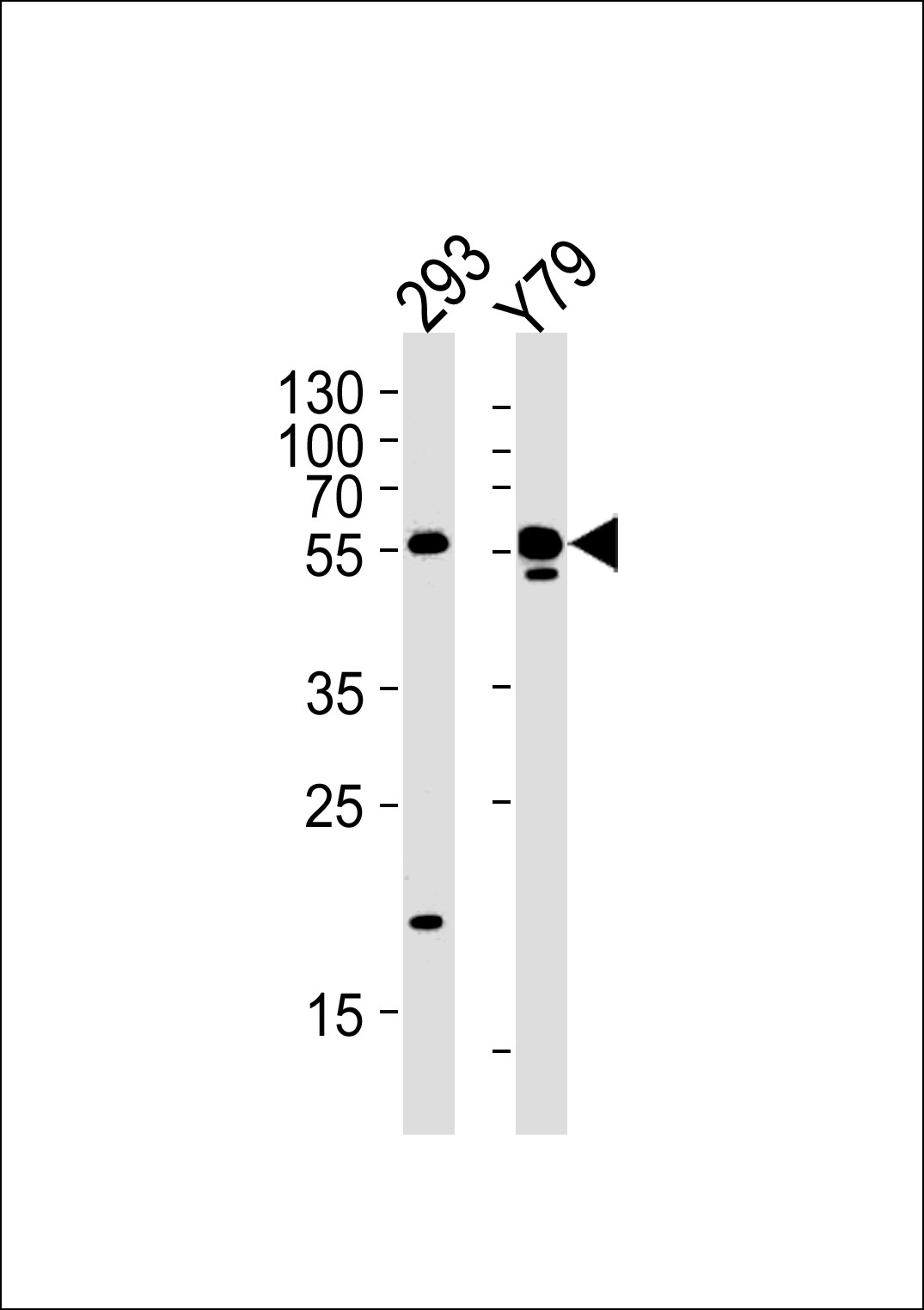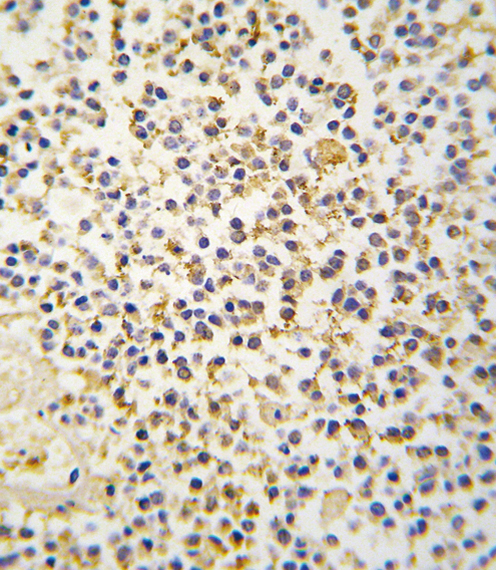ALDH1A3 Antibody (N-term)
Purified Rabbit Polyclonal Antibody (Pab)
- SPECIFICATION
- CITATIONS: 14
- PROTOCOLS
- BACKGROUND

Application
| WB, IHC-P, E |
|---|---|
| Primary Accession | P47895 |
| Reactivity | Human, Mouse |
| Host | Rabbit |
| Clonality | Polyclonal |
| Isotype | Rabbit IgG |
| Calculated MW | 56108 Da |
| Antigen Region | 24-52 aa |
| Gene ID | 220 |
|---|---|
| Other Names | Aldehyde dehydrogenase family 1 member A3, Aldehyde dehydrogenase 6, Retinaldehyde dehydrogenase 3, RALDH-3, RalDH3, ALDH1A3, ALDH6 |
| Target/Specificity | This ALDH1A3 antibody is generated from rabbits immunized with a KLH conjugated synthetic peptide between 24-51 amino acids from the N-terminal region of human ALDH1A3. |
| Dilution | WB~~1:1000 IHC-P~~1:10~50 |
| Format | Purified polyclonal antibody supplied in PBS with 0.09% (W/V) sodium azide. This antibody is prepared by Saturated Ammonium Sulfate (SAS) precipitation followed by dialysis against PBS. |
| Storage | Maintain refrigerated at 2-8°C for up to 2 weeks. For long term storage store at -20°C in small aliquots to prevent freeze-thaw cycles. |
| Precautions | ALDH1A3 Antibody (N-term) is for research use only and not for use in diagnostic or therapeutic procedures. |
| Name | ALDH1A3 |
|---|---|
| Synonyms | ALDH6 {ECO:0000303|PubMed:7698756} |
| Function | Catalyzes the NAD-dependent oxidation of aldehyde substrates, such as all-trans-retinal and all-trans-13,14-dihydroretinal, to their corresponding carboxylic acids, all-trans-retinoate and all-trans- 13,14-dihydroretinoate, respectively (By similarity) (PubMed:27759097). High specificity for all-trans-retinal as substrate, can also accept acetaldehyde as substrate in vitro but with lower affinity (PubMed:27759097). Required for the biosynthesis of normal levels of retinoate in the embryonic ocular and nasal regions; a critical lipid in the embryonic development of the eye and the nasal region (By similarity). |
| Cellular Location | Cytoplasm {ECO:0000250|UniProtKB:Q9JHW9}. |
| Tissue Location | Expressed at low levels in many tissues and at higher levels in salivary gland, stomach, and kidney |

Provided below are standard protocols that you may find useful for product applications.
Background
Aldehyde dehydrogenase isozymes are thought to play a major role in the detoxification of aldehydes generated by alcohol metabolism and lipid peroxidation. The enzyme ALDH1A3 uses retinal as a substrate, either in a free or cellular retinol-binding protein form.
References
Rexer,B.N., Cancer Res. 61 (19), 7065-7070 (2001)
Yoshida,A., Eur. J. Biochem. 251 (3), 549-557 (1998)
If you have used an Abcepta product and would like to share how it has performed, please click on the "Submit Review" button and provide the requested information. Our staff will examine and post your review and contact you if needed.
If you have any additional inquiries please email technical services at tech@abcepta.com.














 Foundational characteristics of cancer include proliferation, angiogenesis, migration, evasion of apoptosis, and cellular immortality. Find key markers for these cellular processes and antibodies to detect them.
Foundational characteristics of cancer include proliferation, angiogenesis, migration, evasion of apoptosis, and cellular immortality. Find key markers for these cellular processes and antibodies to detect them. The SUMOplot™ Analysis Program predicts and scores sumoylation sites in your protein. SUMOylation is a post-translational modification involved in various cellular processes, such as nuclear-cytosolic transport, transcriptional regulation, apoptosis, protein stability, response to stress, and progression through the cell cycle.
The SUMOplot™ Analysis Program predicts and scores sumoylation sites in your protein. SUMOylation is a post-translational modification involved in various cellular processes, such as nuclear-cytosolic transport, transcriptional regulation, apoptosis, protein stability, response to stress, and progression through the cell cycle. The Autophagy Receptor Motif Plotter predicts and scores autophagy receptor binding sites in your protein. Identifying proteins connected to this pathway is critical to understanding the role of autophagy in physiological as well as pathological processes such as development, differentiation, neurodegenerative diseases, stress, infection, and cancer.
The Autophagy Receptor Motif Plotter predicts and scores autophagy receptor binding sites in your protein. Identifying proteins connected to this pathway is critical to understanding the role of autophagy in physiological as well as pathological processes such as development, differentiation, neurodegenerative diseases, stress, infection, and cancer.


